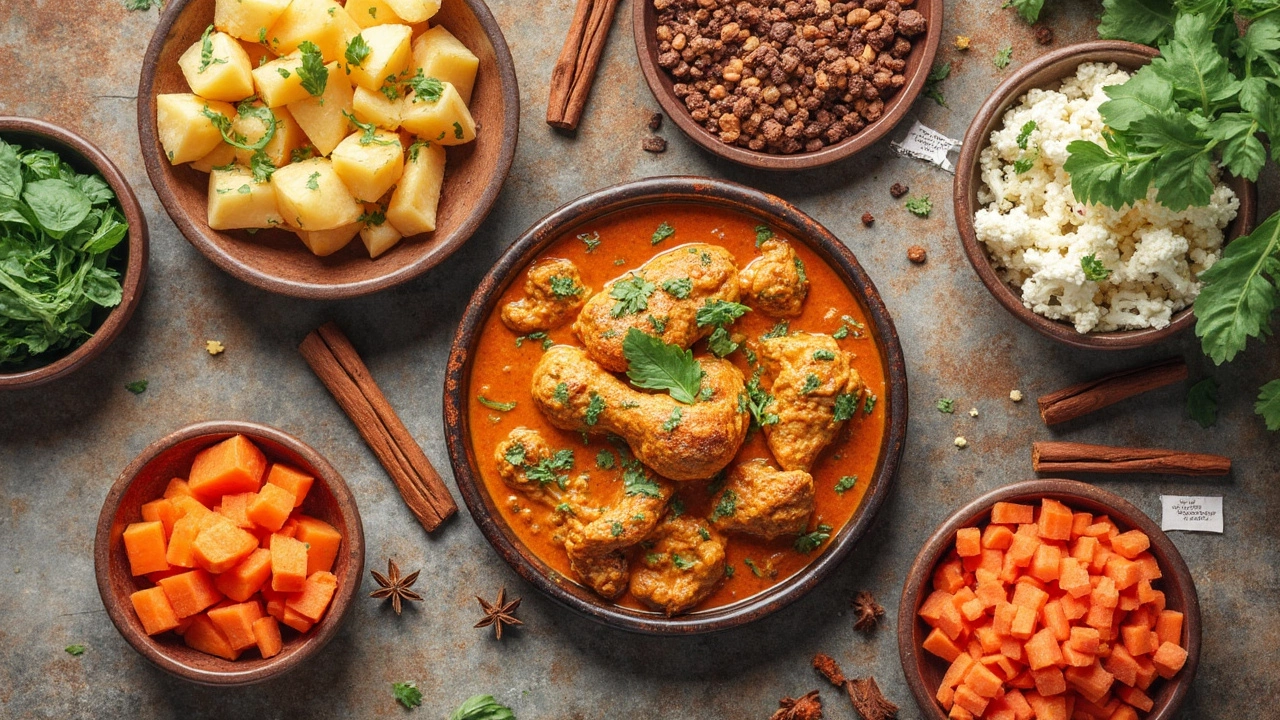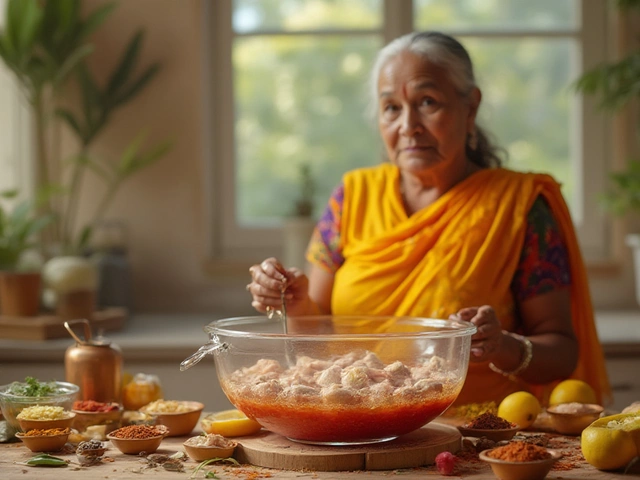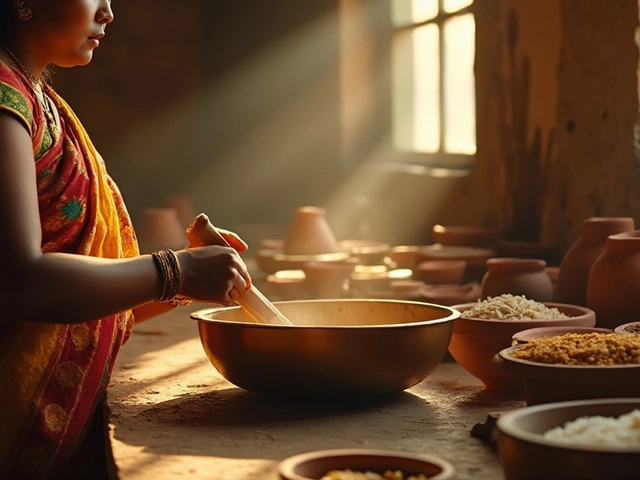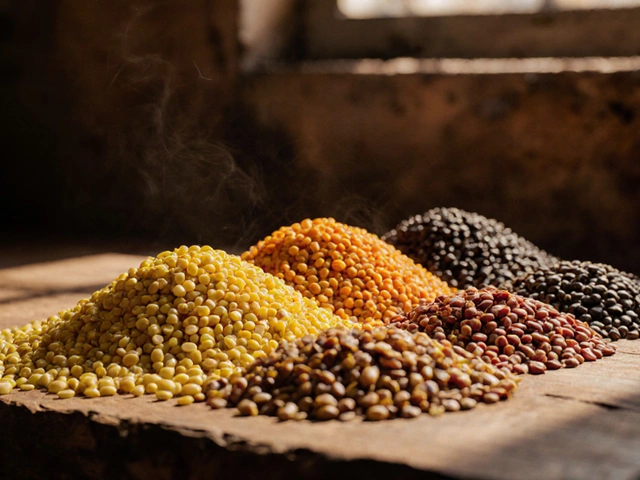If your chicken curry feels a little flat, odds are you’re missing the secret weapon: the right mix of vegetables. Some veggies melt into the sauce and thicken it up, others hold their shape and give each bite some bite. Classic picks include potatoes, carrots, and peas—they don’t just soak up flavor, they stretch the meal and make it more satisfying.
Picking the right veg can totally switch up your curry’s taste or vibe. For example, bell peppers cook up fast and add a bit of sweetness. Cauliflower is a genius move if you want chunky texture without overpowering the chicken. And if you’re aiming for real takeout flavor, a handful of frozen peas—yep, even the cheap bag from the freezer—can make the sauce taste sweeter and look more colorful.
Not every vegetable is a good match, though. Broccoli might seem like a smart choice, but it usually turns mushy before the chicken’s done. Leafy greens like spinach, on the other hand, wilt down quick and bring a hit of color right at the end. Stick with veggies that can hold up to simmering, and don’t be afraid to stick in your fridge’s forgotten oddballs. Curry forgives—and sometimes rewards—experimentation.
- Top Vegetables That Belong in Chicken Curry
- Timing: When to Add Each Veggie
- Why Certain Veggies Stand Out
- Tips for Perfect Texture
- Creative Twists with Less-Common Vegetables
- Mistakes to Dodge When Choosing Curry Veggies
Top Vegetables That Belong in Chicken Curry
If you want your chicken curry to turn out just right, choosing the curry vegetables is a total game-changer. Not every veggie fits the job, though. Certain picks show up in countless kitchens for good reason—they match the flavors, hold their shape, and soak up all that spicy sauce.
Here’s a list of veggies that always work, no matter the style of curry:
- Potatoes: Diced potatoes add bulk, absorb flavors, and make the curry feel more satisfying. Waxy potatoes like Yukon Golds keep their shape better than russets.
- Carrots: Cut into thick pieces, carrots add a bit of sweetness and color. They hold up well even with long simmering.
- Peas: Frozen or fresh, peas get tossed in toward the end. They bring color and a quick, sweet pop.
- Cauliflower: Break into small florets so they cook quickly and soak up flavor without turning mushy.
- Bell Peppers: Red, yellow, or green—they add crunch and a slightly sweet, bright bite.
- Green Beans: Chop them into bite-size pieces. They keep their snap even as they cook and give each bite variety.
- Spinach: Toss a couple of handfuls in right before you turn off the heat. It wilts down and disappears into the sauce, adding iron and a bright green color.
- Tomatoes: Fresh or canned, tomatoes help build the sauce and give it a tangy background.
If you’re feeling practical, here’s a quick cheat sheet on which veggies work best for texture and flavor in chicken curry:
| Vegetable | Role in Curry | Adds Flavor? | Best Time to Add |
|---|---|---|---|
| Potato | Thickens, bulks up curry | Mild, starchy | Early |
| Carrot | Adds sweetness, color | Sweet, earthy | Early |
| Pea | Color, light sweetness | Sweet | End |
| Cauliflower | Texture, soaks up spices | Mild, nutty | Middle |
| Bell Pepper | Crisp bite, sweetness | Sweet, slightly bitter | Middle or end |
| Green Beans | Snap, variety | Fresh, green | Middle |
| Spinach | Nutrient boost, color | Earthy, mild | Very end |
| Tomato | Sauce base, tang | Tangy, rich | Early or middle |
Most home cooks grab at least one or two from this list—you barely ever see a classic chicken curry without potatoes or peas. Don’t be afraid to mix and match, either. There’s room to improvise or swap out based on season or what’s in your fridge. And if you’re all about nutrition, most of these veggies boost vitamins, fiber, and potassium without any fuss or fancy prep.
Timing: When to Add Each Veggie
The timing for adding veggies to a chicken curry recipe can totally make or break your dish. Different vegetables take different times to cook, and dumping them all in at once often leads to mushy peas or rock-hard carrots. No thanks! Let’s break down when those veggies actually belong in the pot.
Hearty veggies need the most time. Potatoes, carrots, and squash should hit the pan right after you’ve fried your spices and added the chicken, before pouring in the liquid. They’ll take a good 20-25 minutes to become tender—the same time it usually takes your chicken to cook through. If you want your potatoes to break down and thicken the sauce, cut them small and give them even longer.
Medium-cookers like cauliflower and green beans should go in about 10 minutes after the potatoes. They hold up under heat but can turn a little too soft if left in too long. Bell peppers only need 5-8 minutes at the end, so throw them in right before your curry is almost finished if you want them crisp. Same goes for snap peas or zucchini—they lose their snap and turn bland if overcooked.
Leafy greens and frozen peas are last-minute add-ins. Just dump spinach or peas in after you turn off the heat, then cover the pot and let everything steam together. This locks in the color and keeps that pop of freshness.
"Vegetable timing is everything: start hard veg early, finish with delicate greens. Overcooked veggies flatten the curry’s flavor and ruin texture." —Samin Nosrat, chef and cooking teacher
Here’s a quick timing guide you can actually use, based on common curry vegetables:
| Vegetable | When to Add | Cook Time |
|---|---|---|
| Potatoes | With chicken and liquid | 20-25 min |
| Carrots | With chicken and liquid | 15-20 min |
| Cauliflower | 10 min before end | 10-12 min |
| Bell Peppers | 5-8 min before end | 5-8 min |
| Green Beans | 10 min before end | 8-10 min |
| Spinach | At the end, after heat is off | 2-3 min (steaming) |
| Frozen Peas | At the end, after heat is off | 2-3 min (steaming) |
Stick to these timings and you’ll get veggies that match your chicken curry, not fight it. Try mixing and matching to see what combos have the perfect bite for you.
Why Certain Veggies Stand Out
Not all vegetables are created equal when it comes to chicken curry. The key is picking vegetables that play nice with bold spices, hold their shape during cooking, and work with the creamy, saucy base. Potatoes are a top choice for a reason—they soak up curry flavors and add natural thickness to the sauce. Carrots do a similar job and bring in just the right touch of sweetness to balance out the heat.
Peas deserve a shoutout, not just for their pop of color but for their tender bite and how quickly they cook. They’re like a cheat code for curry: throw them in during the last few minutes, and you get color without overcooking. Bell peppers are another smart move since they don’t get soggy fast, and their mild flavor doesn’t take over. Cauliflower, meanwhile, holds its own in hot curries, never turning to mush and making every spoonful a little heartier.
Here’s why these curry vegetables really matter:
- Texture: They add body to your curry, soaking up sauce or dishing out satisfying crunch.
- Flavor balance: Sweet veggies (like carrots and peas) can tone down extra-spicy sauces, helping everyone at the table enjoy the meal.
- Nutrition: By tossing in a mix, you bulk up fiber, vitamins, and minerals. It’s a sneaky way to make chicken curry healthier without breaking a sweat.
Plus, different cultures highlight certain veggies for a reason. As Madhur Jaffrey, sometimes called the "Queen of Curry," put it:
“Vegetables in curry aren’t just an afterthought—they’re what make each region’s recipe so unique, adding flavor, color, and character to every bite.”
If you crave a curry where every scoop feels special, don’t just reach for whatever’s lying around. Think about how your veggies will taste after simmering in spices and if they’ll hold up or fade away. That one simple choice is often what makes a good curry taste unforgettable.

Tips for Perfect Texture
Getting your vegetables just right in chicken curry isn’t about luck. It’s all about knowing when to put them in and how long to cook them. Nobody wants soggy carrots or rock-hard potatoes messing with a good meal.
- Cut sizes matter: Keep veggies cut in even sizes, so they cook at the same rate. Thick potato chunks or massive carrot pieces won’t soften up fast enough, leaving you with uneven bites.
- Add in stages: Hard veggies like potatoes, sweet potatoes, and carrots need a head start—they usually take around 15-20 minutes. Peppers and cauliflower only need 8-10 minutes. Fast-cooking greens like spinach? Toss them in for the last couple of minutes.
- Don’t forget about bite: Try not to overcook the peas—they’re best bright and a little firm, not mushy. Once you see them go from dull to bright green, you’re done.
- Stagger for the win: If you’re using three or more veggies, layer their add times. That way, nothing falls apart or turns to mush before the chicken curry is ready.
- Steam vs. stew: Remember, steaming keeps veggies crisper, while direct simmering in sauce makes them softer and full of curry flavor. Think about what texture you want in each bite.
To make things easier, here’s a simple cheat sheet for vegetable cooking times when simmered with chicken curry:
| Vegetable | Prep Tip | Simmer Time (min) |
|---|---|---|
| Potato | Diced 1" pieces | 15-20 |
| Carrot | Sliced 1/2" rounds | 12-15 |
| Cauliflower | Small florets | 8-10 |
| Peas | Frozen | 3-5 |
| Spinach | Rough chopped | 2-3 |
| Bell Pepper | 1/2" strips | 8-10 |
One last tip: resist the urge to constantly stir. You want your veggies to hold up, not break up. Let them chill out in the curry, soak up the flavor, and you’ll nail that perfect mix of soft, toothsome, and saucy every time.
Creative Twists with Less-Common Vegetables
If you’re ready to shake up your chicken curry, there’s a whole world beyond potatoes and carrots. Sometimes the unexpected choices end up being everyone’s favorite. The most fun part? A lot of these veggies boost nutrition or bring out flavors you won’t get from the usual suspects.
You’ve probably seen sweet potatoes pop up in trendy curry recipes. They cook up creamy, add a splash of color, and their natural sweetness cools down hot spices. Shredded cabbage is another surprise winner—it softens fast and gives the curry extra bulk. Ever tried eggplant (aubergine) in curry? It soaks up sauce like a sponge and makes each bite super rich.
Here are a few less-common veggies to try in your next round of curry vegetables:
- Zucchini: Quick to cook, mild, and works for light or summery curries. Toss it in last so it doesn’t get soggy.
- Butternut squash or pumpkin: These stay firm but creamy and their sweetness balances spicy heat perfectly.
- Green beans: They’ll add crunch and color. Throw them in during the last 10 minutes of simmering.
- Okra: Super popular in South Indian-style curries for thickening up the sauce and adding silky texture.
- Beetroot: Earthy flavor and wild magenta color. Maybe not classic, but definitely memorable.
Want to know which veggies pack the most nutrients? Check out this quick breakdown to spot a healthy pick at a glance.
| Vegetable | Main Nutrients | Cooking Time |
|---|---|---|
| Sweet Potato | Vitamin A, fiber, potassium | 20-25 min |
| Eggplant | Fiber, antioxidants | 15-20 min |
| Butternut Squash | Vitamin C, potassium | 25-30 min |
| Zucchini | Vitamin C, manganese | 5-8 min |
| Beetroot | Folate, fiber | 30-35 min |
Tossing in these veggies is simple. If your curry cooks quickly, stick with zucchini or green beans. For slow-cooked chicken curries, go bold with beetroot or squash—they’ll soak up every bit of flavor. Just don’t forget: cut everything about the same size so it cooks evenly.
If you want to mess around with textures and flavors, try mixing two or three less-common veggies. It keeps things interesting and you won’t ever get bored with the same old bowl of curry.
Mistakes to Dodge When Choosing Curry Veggies
Picking veggies for chicken curry seems easy, right? But even seasoned cooks mess this up. Wrong choices can make your curry taste odd, feel mushy, or totally clash with the sauce. Here’s where most folks slip up—and how you can avoid those flops.
- Overloading on watery veggies: Zucchini, tomatoes, or eggplant might sound good, but too much of these can water down your sauce way more than you want. The curry loses its punch, and you end up with a thin, bland mess. Save these for lighter curries or add them near the end if you have to.
- Different veggies, same cooking time? Not a chance. Potatoes take much longer to soften than snap peas or spinach. If you toss everything in at once, you'll have some veggies that are mushy and others that still crunch. Add firmer veggies first, quick-cookers last.
- Bland picks: Some veggies just don’t jive with strong curry flavors. For example, green beans or celery don’t absorb the spices well and can actually make the dish taste flat. Stick with choices known to soak up flavor—see the table below for some reliable options and their average cook times.
- Forgetting about color and texture: If your curry is all the same color or everything turns to mush, you probably won’t want seconds. Mix in veggies with different colors and textures for a plate that looks and tastes better.
- Skipping the season: Out-of-season veggies can look fine but taste like cardboard. Always taste a bite raw before adding it to your curry. If it’s bland, it won’t get better after simmering.
| Vegetable | Soaks Up Curry Flavor | Cook Time (minutes) |
|---|---|---|
| Potatoes | Yes | 18–22 |
| Carrots | Yes | 12–15 |
| Bell Peppers | Moderate | 5–8 |
| Cauliflower | Yes | 10–12 |
| Frozen Peas | Yes | 3–4 |
| Eggplant | Moderate | 10–13 (watery) |
| Green Beans | No | 6–9 |
| Spinach | Yes | 1–2 |
Don’t forget the golden rule for curry vegetables: taste as you go and adjust. Your sauce will only be as good as what’s in it. If you’re ever stuck, go classic—potatoes, carrots, and peas never let you down. And keep those watery picks in check, unless you want soup instead of curry.











